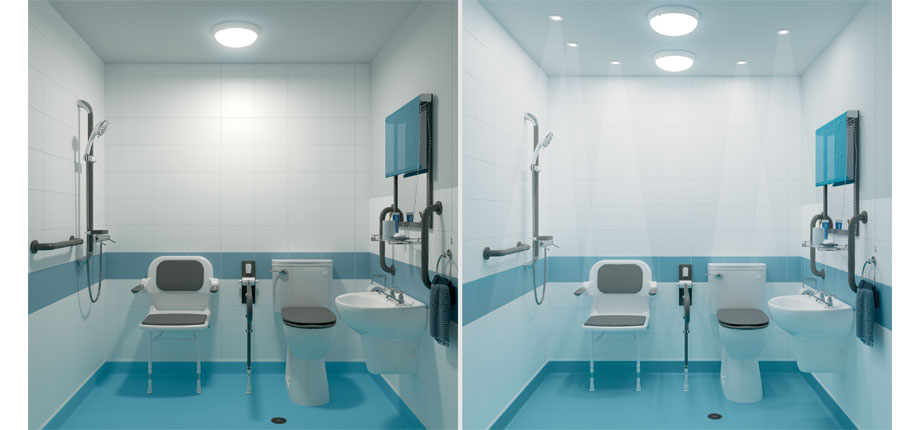In the UK, bathroom falls account for a quarter of all hospital admissions . Unsurprisingly the 80+ age range is most at risk from hospital admission due to bathroom falls, with 8% admitted per year . In addition, the number of people aged 65+ entering hospital as a result of a fall is predicted to increase by almost 50% - to almost half a million - by 2035 . The bathroom is a high risk fall area, particularly for those with sight loss, mobility issues or dementia. Here, Stuart Reynolds, Head of Product and Marketing at AKW, discusses how to overcome two of the most common causes of bathroom falls in this space: poor lighting and trip and slip hazards.
Well lit - to avoid bathroom falls
Over the age of 60, people need three times more light than they did when they were 20, and the majority wear glasses – that they tend to take off when in the bathroom. Therefore, the role of good lighting in fall prevention cannot be underestimated. In a standard bathroom, there is usually a single LED or fluorescent light that can throw shadows where light is needed the most.
For those with low vision, dementia or mobility issues, the avoidance of shadows, dark areas and glare is key to safe movement around the space. With this in mind, a mix of task-specific lighting and overall ambient lighting is needed to deliver adequate light levels for showering, shaving and other personal care activities.
Task focused lighting is best achieved through the use of fittings installed on the ceiling that contain an LED that throws a narrow beam of light onto a specific space, such as the shower area, or sink. To maintain ambient light levels in the bathroom however, LED ceiling lights should be spaced to maximise coverage and minimise shadowing.

AKW's Task Focused Lighting Kit
To help, AKW has created a bathroom lighting pack. It contains everything needed to light a standard UK bathroom (with additional products that can be purchased separately for larger spaces). The products also conform to all relevant industry standards for a bathroom installation.
Safety flooring and colour contrast to avoid slips and bathroom falls
From frayed carpet, to slippery laminate or vinyl flooring, unsuitable bathroom floor coverings can also be a cause of trips and falls. As well as choosing non-slip vinyl safety flooring that has a PTV (Pendulum Test Value) rating of ≥36, it is worth considering colour contrast for those with sight loss, mobility issues or dementia. For those with visual impairment issues, their ability to identify differences in colour is the amount of light the surface reflects (a light reflectance value (LRV) rating).
Building Regulations sets a minimum of 30 LRV points of colour contrast between neighbouring items. Each colour has a score from 0-100, with brilliant white rating at LRV100 and jet black at LRV0. A very good point of difference could be achieved with magnolia coloured walls (LRV82) and AKW’s Cerulean blue cut-to-order, anti-slip, vinyl safety flooring (LRV16). It is also worth avoiding patterned and shiny finishes, as these can be perceived as confusing or slippery to those with visual impairments or dementia.
To ensure that anti-slip protection runs throughout the bathroom, the shower area should have an anti-slip surface as well. For example, AKW’s Braddan level access shower tray can be recessed into the floor and comes with a slip resistance surface.
Good lighting and anti-slip flooring and shower surfaces have the potential to dramatically reduce the fall risk for those with sight loss, mobility issues or dementia in the bathroom, as well as promoting their independence for the long-term. Now that’s something worth investing in.
A free guide on how to light accessible bathrooms, created by AKW in conjunction with occupational therapists, is available here. Also, visit the website for more information on AKW’s anti-slip flooring and shower tray ranges.
- Log in to post comments













